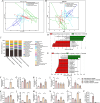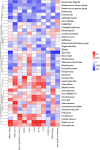Co-housing with Tibetan chickens improved the resistance of Arbor Acres chickens to Salmonella enterica serovar Enteritidis infection by altering their gut microbiota composition
- PMID: 39748400
- PMCID: PMC11697627
- DOI: 10.1186/s40104-024-01132-2
Co-housing with Tibetan chickens improved the resistance of Arbor Acres chickens to Salmonella enterica serovar Enteritidis infection by altering their gut microbiota composition
Abstract
Background: Salmonella enterica serovar Enteritidis (S. Enteritidis) is a global foodborne pathogen that poses a significant threat to human health, with poultry being the primary reservoir host. Therefore, addressing S. Enteritidis infections in poultry is crucial to protect human health and the poultry industry. In this study, we investigated the effect of co-housing Arbor Acres (AA) chickens, a commercial breed susceptible to S. Enteritidis, with Tibetan chickens, a local breed resistant to S. Enteritidis infection, on the resistance of the latter to the pathogen.
Results: Ninety-six 1-day-old Tibetan chickens and 96 1-day-old AA chickens were divided into a Tibetan chicken housed alone group (n = 48), an AA chicken housed alone group (n = 48), and a co-housed group (48 birds from each breed for 2 cages). All birds were provided the same diet, and the experimental period lasted 14 d. At d 7, all chickens were infected with S. Enteritidis, and samples were collected at 1-, 3-, and 7-day-post-infection. We found that the body weight of AA chickens significantly increased when co-housed with Tibetan chickens at 1- and 3-day-post-infection (P < 0.05). In addition, the cecal S. Enteritidis load in AA chickens was significantly reduced at 1-, 3-, and 7-day-post-infection (P < 0.05). Furthermore, the inflammatory response in AA chickens decreased, as evidenced by the decreased expression of pro-inflammatory cytokines NOS2, TNF-α, IL-8, IL-1β, and IFN-γ in their cecal tonsils (P < 0.05). Co-housing with Tibetan chickens significantly increased the height of villi and number of goblet cells (P < 0.05), as well as the expression of claudin-1 (P < 0.05), a tight junction protein, in the jejunum of AA chickens. Further analysis revealed that co-housing altered the gut microbiota composition in AA chickens; specifically, the relative abundances of harmful microbes, such as Intestinimonas, Oscillibacter, Tuzzerella, Anaerotruncus, Paludicola, and Anaerofilum were reduced (P < 0.05).
Conclusions: Our findings indicate that co-housing with Tibetan chickens enhanced the resistance of AA chickens to S. Enteritidis infection without compromising the resistance of Tibetan chickens. This study provides a novel approach for Salmonella control in practical poultry production.
Keywords: Salmonella enterica serovar Enteritidis; Arbor Acres chicken; Co-housing; Gut microbiota; Tibetan chicken.
© 2025. The Author(s).
Conflict of interest statement
Declarations. Ethics approval and consent to participate: All animal experiments were conducted in accordance with the Regulations of the Experimental Animal Administration issued by the State Committee of Science and Technology of the People’s Republic of China, approved by the Animal Care and Use Committee of the Poultry Institute, Chinese Academy of Agriculture Science (approval No. CNP20220410). Consent for publication: Not applicable. Competing interests: The authors declare that they have no competing interests.
Figures






Similar articles
-
Florfenicol Enhances Colonization of a Salmonella enterica Serovar Enteritidis floR Mutant with Major Alterations to the Intestinal Microbiota and Metabolome in Neonatal Chickens.Appl Environ Microbiol. 2021 Nov 24;87(24):e0168121. doi: 10.1128/AEM.01681-21. Epub 2021 Oct 6. Appl Environ Microbiol. 2021. PMID: 34613752 Free PMC article.
-
Model of Persistent Salmonella Infection: Salmonella enterica Serovar Pullorum Modulates the Immune Response of the Chicken from a Th17-Type Response towards a Th2-Type Response.Infect Immun. 2018 Jul 23;86(8):e00307-18. doi: 10.1128/IAI.00307-18. Print 2018 Aug. Infect Immun. 2018. PMID: 29760212 Free PMC article.
-
Dietary l-arginine supplementation ameliorates inflammatory response and alters gut microbiota composition in broiler chickens infected with Salmonella enterica serovar Typhimurium.Poult Sci. 2020 Apr;99(4):1862-1874. doi: 10.1016/j.psj.2019.10.049. Epub 2020 Mar 10. Poult Sci. 2020. PMID: 32241466 Free PMC article.
-
Differences in expression of genes in the MyD88 and TRIF signalling pathways and methylation of TLR4 and TRIF in Tibetan chickens and DaHeng S03 chickens infected with Salmonella enterica serovar enteritidis.Vet Immunol Immunopathol. 2017 Jul;189:28-35. doi: 10.1016/j.vetimm.2017.05.003. Epub 2017 May 11. Vet Immunol Immunopathol. 2017. PMID: 28669384
-
Immune responses against Salmonella enterica serovar enteritidis infection in virally immunosuppressed chickens.Clin Diagn Lab Immunol. 2003 Jul;10(4):670-9. doi: 10.1128/cdli.10.4.670-679.2003. Clin Diagn Lab Immunol. 2003. PMID: 12853403 Free PMC article.
References
-
- Wibisono FM, Wibison FJ, Effendi MH, Plumeriastuti H, Hidayatullah AR, Hartadi EB, et al. A review of salmonellosis on poultry farms: Public health importance. Sys Rev Pharm. 2020;11(9):481–6.
Grants and funding
LinkOut - more resources
Full Text Sources

